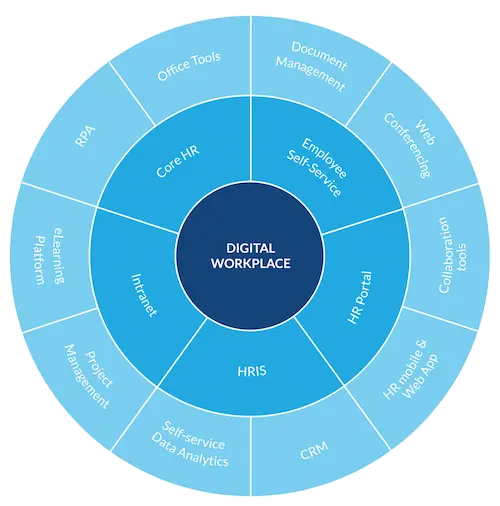Technologies such as mobile apps and cloud computing continue to transform the way people work and breed new models of workplaces. Thus, they help to drive higher levels of productivity and employee engagement.
In this digital age, the line separating workers’ professional and personal lives becomes more blurred than ever. 9-to-5 is no longer the standard. And people now demand to work wherever and whenever they see fit. To accommodate this new way of working, businesses are seeking to build a digital workplace that enables remote collaboration and effortless employee experience. That means the nature of the workplace is changing: from a physical premise, it is now a digital environment that can be accessed from anywhere and at any time.
Why Digital Workplace is the future of work
Built on digital technologies, a digital workplace refers to a virtual work environment that allows workers to do their jobs and collaborate with others at any time, in any place, and through any digital device.

The Digital Workplace Model
As a pillar of a successful Digital Transformation, a digital workplace can empower a company’s employees in various ways.
Support new ways of working: Equipped with the right digital tools, workers can now work the way they wish. Today’s workers expect to handle their workloads outside the 9-to-5 mentality and occasionally inside their “home office”. As telecommuting and working-from-home is trending upwards, an integrated HR employee app is what workers need to stay engaged and connected with their company and their colleagues. To have an HR employee app, companies can either acquire off-the-shelf products with integrated functionalities or build a proprietary app from scratch for customization.
Enable virtual communications. In addition to HR mobile apps, communication platforms such as enterprise intranet or portal and instant messaging applications allow workers to stay in touch with colleagues, with their business systems, and with clients practically around the clock.
Build an agile, governed virtual work environment. With Human Resource Information System (HRIS), HR practitioners can virtually manage employee records and automate most of the repetitive HR processes, thus ridding themselves of cumbersome spreadsheets. In the meantime, non-HR workers can easily access these platforms for information regarding policies, payroll, .
Attract and retain talents. Top employees and candidates expect top work environments. They will stay with a business that provides them with progressive and innovative technologies. When it comes to employee attraction and retention in a digital workplace, companies will need to have easy-to-use recruitment tools and HR onboarding platforms.
Improve working and life experience. As workers are provided with the tools they need to get their work done faster and collaborate more effectively, they become happier with work and life. In a study by CMSWire, 74% of surveyed CIOs agreed that enterprise apps have raised their workers’ satisfaction levels.
The 3 imperatives of a digital workplace
- Borderless collaboration: Collaboration among employees and workgroups has extended beyond the organization’s firewalls. Companies are equipping their employees with communication tools to work and collaborate. On top of that, they expect their working experience to be easy and effortless. Along with customer experience, employee experience is becoming another key consideration of a thorough Digital Transformation.
- Modern workplace: Work has moved from traditional hard-copies, sign-offs, and emails to highly interactive digital tools such as Slack, MS Teams, Google Docs, or Office 365. No matter where or when people are, they can co-create values, get notified of important events, and join in conversations.
- Automation Technologies: Automations facilitate business processes, freeing workers from the tedious paperwork so that they can focus on more purposeful work, therefore delivering real value for the organization.
Borderless collaboration
It’s a norm that today’s workplaces are equipped with mobile and web applications so that workers can handle their jobs faster and smarter. Indeed, these apps function as their digital workplace.
Take customer-facing salespeople at the store-front for example. With mobile applications, they can instantly access product information, data of similar products, or promotions programs whenever they need. Since information and insights is literally available at their fingertips, salespeople have higher chances to close sales, recommend other products, or “cross-sell” customers on other items.
Today, it’s also common that workers create chat groups in instant messaging tools such as Skype or Telegram to get their conversations going. Such tools enable cross-boundary collaboration, which can open up new sales opportunities.
Let’s picture a retail store’s staff who manages its e-commerce site happens to receive a request for an air conditioner. This staff quickly “buzzes” the Telegram chat group of salespeople. Just as quickly, one salesperson at the nearest store jumps in, who then calls the customer to consult everything he could about air conditioners—from which brand is in vogue to how much it costs to install. Finally, he closes the sales order along with the same-day delivery and installation order.
This scenario would be impossible without digital tools and digital collaboration: Just guess how long it would take for the call center to log this request to the system, and wait for the dispatcher route and the store staff. It then takes a while for the manager to decide who will deal with the customer based on who is on shift and has the relevant skill (related to air conditioner in this case). By the time the task is assigned to the appropriate staff, the customer might have already decided to buy somewhere else.
However, sometimes many workplace tools or HR platforms are not as effective as they should be. The enterprise help desk ticket system is a case in point. It is supposed to be a one-stop-shop for employees to submit their requests. However, most people think logging all the required information is not worth the trouble. So they lean to personal networks for help.
The promises of digital tools are great. But there is another downside: these tools are causing distractions that hamper productivity. To prevent that from happening, leaders need to look into the protocols, defining boundaries in ways that encourage collaboration while minimizing the distractions.
Modern Workplace
Unlike a traditional call center that receives requests only through telephone lines, the modern call center should handle inbound and outbound customer interactions via multiple channels such as telephone, web interface, instant messaging, and social media. This kind of modern contact center helps resolve customer inquiries quickly and track customer interactions more effectively.
This change is apparent in the Banking and FSI sectors alike. According to Backbase’s FINTECH AND DIGITAL BANKING 2025 ASIA PACIFIC, mobile transactions are expected to grow by 3 times in the upcoming 4 years, while modernization is seen as the top 2nd priority among the largest banking players. When millions of customers refuse to visit physical branches and instead opt for digital channels such as mobile banking apps, banks are forced to digitize their workforce and workplace to adapt.
Having said that, the reality is far from exciting, since businesses are still working on the basics. Companies that refuse to adopt document management systems are sticking to the cumbersome hard-copies, time-consuming approval workflow sign-offs; as a result, they risk worsening employee dissatisfaction. Without a central HR system, promotion programs and companies’ policies are flying around in emails, and then they get lost. As the volume of data keeps growing, people need modern tools to stay on top of the information flow inside and outside the company. Otherwise, they got stuck somewhere in the sales process or could not improve sales performance.
The next-gen teams are moving on to collaboration platforms such as Slack, Microsoft Teams, Facebook workplace, or even a proprietary platform built from scratch. According to a report by Deloitte, collaboration tools can help companies make employees 34% happier with the existing workplace culture. These platforms help businesses bring together different types of teams and professionals, which enables them to work together effectively and more often remotely. Working is therefore more collaborative than ever before. Conversations can happen any time within the preferred channels, where everyone can take part in. Meetings can be scheduled or ad-hoc. Notifications pushed to the people who need them, rather than having to scan through hundreds of emails during the day.
AirAsia operations teams use Groups and Workplace Chat to connect people from the apron to the terminal and at airports across Asia and Australia. They use Groups to get accurate information about changes to flights. This enables pilots to react more quickly, helps operations teams to solve problems in real-time, and is more efficient than using traditional email distribution lists.

Automation Technologies
Automation continues to change how people work and how jobs get done. Process Automation is nothing new. Businesses have always looked for ways to automate and achieve greater efficiency.
Automation began more than two centuries ago in heavy industries such as textiles or automobiles where factory machines partially handled labor-intensive tasks.
But now, as the nature of work has changed, so has the method of automation. Businesses have applied ERP and purpose-built applications such as CRM, Project Management, eLearning Platform, and Core HR Platform. However, some businesses still work with not-so-optimal processes and applications that hardly integrate with each other, which translates into increased cost and inconsistent quality.
To date, businesses have responded to the challenges in various ways such as investing in a newer or better enterprise application, or outsourcing processes to a third party or applying Robotic Process Automation (RPA) tools in certain scope to generate quick wins. A Capgemini’s survey has pointed out that about 9 out of 10 companies believed that RPA can enhance the quality of work.
Rather than requiring a large-scale process overhaul with huge investments, RPA tools help build the software-robot, perform routine based business processes, and mirror the way people interact with applications through a user interface and based on predefined rules.
RPA tools these days have reached a level of maturity that attracts many businesses’ attention. A “robotic workforce” like this can typically be deployed in a matter of weeks.

Conclusion
The evolution of the digital workplace is accelerating. It is the future of work, where the focus shifts in order to enable collaboration, remote working, real-time communications, and automation. We hope these findings will help your organization in the digital transformation journey.
If you want to learn more about Digital Transformation and how to build a roadmap for your Digital Journey, download our latest paper “Digital Strategy: Delineate a Roadmap for your Digital Transformation“







